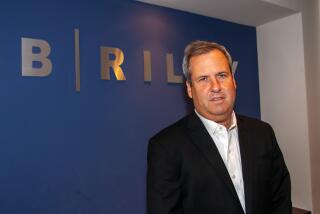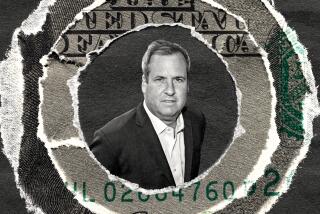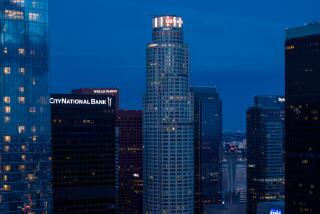Federal Lawsuit Claims Ex-Lincoln S&L; Officials Schemed to Divert Funds
- Share via
Federal regulators filed a lawsuit Friday in Phoenix charging that the former operators of Irvine-based Lincoln Savings & Loan devised a racketeering scheme to siphon $1.1 billion in federally insured deposits from the now-insolvent thrift for their own use.
The suit, filed in U.S. District Court, is the largest ever filed against directors and officers of failed institutions. With punitive damages and trebling provisions under the federal Racketeer Influenced and Corrupt Organizations Act, the government is seeking to recover up to $2.4 billion from the defendants.
Industry experts estimated that Lincoln’s collapse will cost taxpayers up to $2.5 billion, which would make it the costliest S&L; failure in history.
The suit alleges that Charles H. Keating Jr., chairman of American Continental Corp., and other executives bought the S&L; in 1984 and began “to divert . . . Lincoln’s deposits and assets to themselves” through a wide range of “illegal, fraudulent and imprudent acts,” including false and misleading statements to regulators, forgery and concealment of illegal cash payments.
The racketeering scheme was devised to fuel the operation’s “speculative” business ventures, from securities trading to real estate deals, the suit said. And to further the scheme, the suit claims, the defendants “engaged in a pattern of deception to mask prohibited and sham transactions from regulatory scrutiny.”
The suit also seeks to freeze the assets of Keating, who is a multimillionaire, and others, allowing each to live on $3,000 a month.
Keating was out of town and could not be reached for comment.
A lawyer for Phoenix-based American Continental called the racketeering charges “mean-spirited” on the part of regulators and denied that Keating and the other 36 defendants were liable for any of the 14 claims made in the lawsuit.
“There are no surprises here,” said Melvin A. McDonald, a lawyer for the company, about the allegations. “This is the same old wine in the same old bottles--the same information regulators have had for years. They’re just trying to put new labels on the bottles.”
The suit stemmed from an in-depth investigation by regulators, said Alan Whitney, spokesman for the Federal Deposit Insurance Corp., which insures deposits at Lincoln. “We have a clear responsibility to take legal action where appropriate to reduce any losses to American taxpayers growing out of fraudulent financial activity,” he said.
Regulators seized Lincoln on April 14, a day after American Continental filed for bankruptcy. Regulators declared the S&L; insolvent on Aug. 2 after disclosing $788 million in losses in the second quarter, which ended June 30, and put Lincoln in receivership.
The suit is the first major legal action brought by the Resolution Trust Corp. since it was created last month by a new federal law to handle failed banks and thrifts. The RTC brought the suit as receiver for Lincoln.
The suit alleges four RICO violations and three violations of Arizona’s racketeering laws against Keating and six executives, including his son and two sons-in-law. An additional seven allegations accuse the defendants--20 individuals and 17 companies--of fraud, conspiracy, negligence and violations of regulatory laws.
The defendants also include William J. Keating, a former congressman and former publisher of the Cincinnati Enquirer. He is Charles Keating’s brother. Their spouses and those of several other defendants were also named in the suit.
Because it is in bankruptcy, American Continental itself was not named as a defendant.
Keating and the other defendants are accused of wrongdoing in transactions involving high-yield corporate securities known as junk bonds, corporate stock bought by American Continental’s employee stock ownership plan, land sold to related parties allegedly for above-market prices and straw borrowers and straw purchasers allegedly used to avoid direct investment regulations.
The suit also claims that American Continental wrongly appropriated money from Lincoln to pay corporate taxes, resulting in a $125-million loss of income to the S&L.;
Much of the alleged wrongdoing, the suit said, was the result of Keating’s effort to get around federal regulations that limited the amount of money that Lincoln could use to take ownership positions in numerous investments, such as real estate and securities.
Keating has been an outspoken critic of the limitations on direct investments and has battled with regulators over various rules almost since American Continental bought Lincoln in February, 1984.
To avoid complying with the limitations, the suit said, Keating and others disguised the investments as loans or sales.
Manipulation Alleged
In one example cited in the suit, Keating and others sold a residential development to R.A. Homes in Phoenix. The transaction was financed through Lincoln and, despite the sale, Keating entities maintained control over the development. R.A. Homes is operated by Ron Ober, who has been the campaign manager for three election campaigns of Sen. Dennis DeConcini (D-Ariz).
In addition to real estate transactions, the suit alleges, the defendants manipulated a number of stock sales and purchases that will result in more than $22 million in damages to Lincoln.
In one transaction, the defendants allegedly caused Lincoln to sell stock in Memorex International to a third party for $1 million--after the investment banking firm of Drexel Burnham Lambert sent a letter saying the stock was worth $2.8 million. The third party soon sold the stock to American Continental for $2 million, and the company later sold the stock at its market value--$13.3 million. The suit claims that the company misappropriated $11.3 million in profits that should have gone to Lincoln.
Focus on Insider Loans
And the defendants also tried to avoid regulations limiting loans to insiders, the suit said. The primary example involved funds that Lincoln made available to Southmark Corp. in Dallas and its subsidiaries and about $35 million in loans that Southmark’s thrift subsidiary, San Jacinto Savings & Loan, made to a Keating-led partnership that owns the Pontchartrain Hotel in Detroit.
McDonald was angered that the suit named the spouses of some American Continental executives as defendants. Though not named as racketeering defendants, he said, the spouses named in the suit suffer the same “powerful” stigma that attaches to other defendants.
“When I see racketeering charges against family members, I think it’s being used to break Keating,” he said.
Freeze on Assets
Racketeering claims also may prevent the defendants from turning to their corporate insurance policy for their legal defense and any damages, he said. And any freeze on assets could hinder Keating and other defendants from hiring effective counsel, he said.
Several sources said regulators had been debating internally for a month about whether to bring racketeering claims and seek to recover damages from Keating’s assets or sue only for fraud and work out a more certain settlement with the insurance carrier covering director and officer liability.
The lawsuit also could bolster ongoing investigations by the FBI and the Securities and Exchange Commission. The FBI’s criminal investigation, which started in Los Angeles, has been transferred to Phoenix because Lincoln’s assets were primarily in Arizona property and the S&L;’s investments were overseen by American Continental management. The SEC has been probing allegations of securities law violations.
Senators Intervened
The racketeering claims against Keating also may further blacken the eyes of five senators, including DeConcini and Sen. Alan Cranston (D-Calif.), who made inquiries on his behalf with regulators in the past. None of the legislators were mentioned in the suit.
Keating and his executives contributed at least $300,000 to election campaigns of the senators and, at Cranston’s request, gave an additional $850,000 to three nonpartisan voter registration groups, one of which was formed by Cranston’s son.
The senators twice intervened at Keating’s behest two years ago to question regulators about an unusually long financial examination of Lincoln.
A RECENT HISTORY OF LINCOLN SAVINGS & LOAN
February, 1984: American Continental Corp., a Phoenix-based real estate development company headed by Charles H. Keating Jr., purchases Lincoln Savings & Loan in Irvine for $51 million.
March, 1986: The Federal Home Loan Bank Board begins a lengthy audit of Lincoln.
December, 1986: American Continental wins approval from the California Department of Corporations to sell subordinated debentures--essentially corporate IOUs--at Lincoln’s 29 branches in Southern California. Over the next two years, some 22,000 people buy nearly $200 million in debentures.
April, 1987: Sens. Alan Cranston (D-Calif.), Dennis DeConcini (D-Ariz.), John McCain (R-Ariz.) and John Glenn (D-Ohio) meet privately with Edwin J. Gray, then the bank board’s chairman. They question the unprecedented length of the Lincoln examination and a proposed regulation that would hinder Lincoln’s operations. A week later, the senators, joined by Sen. Donald Riegle (D-Mich.), question bank board examiners about the audit.
May, 1988: Lincoln Savings settles its long-running dispute with thrift regulators by agreeing to raise up to $160 million in new capital. In response to Lincoln’s request that oversight of the S&L; be transferred to another field office, the bank board’s main office in Washington took over supervision from San Francisco. The bank board immediately initiates a new audit.
May, 1988: The California Department of Corporations approves more sales of debentures despite objections from the California Department of Savings and Loan. A short time later, the thrift regulatory agency refuses to allow the company to sell the bonds at Lincoln branches.
December, 1988: American Continental agrees to sell Lincoln to a Southern California investment group headed by longtime industry executive Spencer Scott in a stock transaction valued at $288.75 million. Soon after the agreement is announced, federal regulators claim that Lincoln does not have enough capital to support its operations and should stop all non-traditional S&L; activities until they can review the sale.
March, 1989: After the sales agreement for Scott’s group expires in February, a new group of investors, headed by former U.S. Rep. John Rousselot, reaches a tentative agreement to buy Lincoln.
April 13, 1989: American Continental files for protection from creditors under Chapter 11 of the federal bankruptcy code. In an unusual twist, it also puts 11 Lincoln subsidiaries in bankruptcy.
April 14, 1989: The bank board seizes Lincoln, saying its parent firm was operating it unsafely, and immediately asks the FBI to investigate allegations of criminal activity that may have caused the S&L;’s collapse.
August, 1989: Regulators announce that Lincoln lost $788 million in the second quarter and declare Lincoln insolvent. Regulators put it in receivership, cutting off all rights of owners and debt holders to S&L; assets.
Sept. 15, 1989: Regulators sue Keating and other American Continental directors and officers in a racketeering suit that seeks $1.2 billion in damages, the largest amount ever sought by regulators in litigation over a failed S&L.;
More to Read
Inside the business of entertainment
The Wide Shot brings you news, analysis and insights on everything from streaming wars to production — and what it all means for the future.
You may occasionally receive promotional content from the Los Angeles Times.










